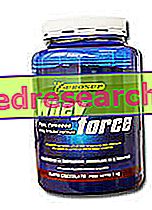
Information about Whey Force - Eurosup
WHEY FORCE - EUROSUP
Dietary supplement of concentrated and isolated whey protein, with Vitamin B6
FORMAT
Pack of 1 or 2 kg, various flavors
COMPOSITION
Whey protein concentrate and isolate. Low-fat cocoa powder, flavors supported on gum arabic and maltodextrin, Emulsifier: soy lecithin,
Bromelain 2400 GDU. Sweeteners: sucralose, acesulfame, Vitamin B6
Media Analysis (Gusto Cacao) | For 100 g | Per daily dose (30 g) |
Energy value | 394 Kcal / 1663 Kj | 118 Kcal / 499 Kj |
Protein | 76 g | 22.8 g |
Carbohydrates | 7 g | 2.1 g |
of which sugars | 5.9 g | 1.77 g |
Grassi | 6.3 g | 1.89 g |
of which Saturi | 3.5 g | 1.05 g |
fibers | 2.4 g | 0.72 g |
Sodium | 160 mg | 48 mg |
Bromelain 2400 GDU | 100 mg | 30 mg |
Vitamin B6 | 1.4 mg | 0.42 mg |
Amino acid profile | For 100 g |
L-isoleucine | 3.47 g |
L-Leucine | 9.52 g |
L-Valine | 3.40 g |
L-Lysine | 7.28 g |
L-Methionine | 1.43 g |
L-Phenylalanine | 2.66 g |
L-threonine | 4.02 g |
L-Arginine | 2.04 g |
L-Alanine | 4.02 g |
L-aspartic Acid | 8, 34g |
L-cystine | 2.17 g |
L-Glutamic acid | 12.56 g |
L-Glycine | 1.56 g |
L-histidine | 1.43 g |
L-Proline | 3.47 g |
L-Serine | 3.40 g |
L-Tyrosine | 2.72 g |
L-Tryptophan | 1.56 g |
Product features Whey Force - Eurosup
Whey protein extraction methods - whey proteins are marketed with different abbreviations, indicating the different production methods:
- WPC: whey protein concentrate;
- WPI: whey protein isolate;
- WPH: whey protein hydrolyzed;
All these forms, which are generally the most commercially available, are characterized by an average concentration of proteins ranging between 70 and 80%, while the remainder is occupied by fats and carbohydrates. A higher protein titration is obtained through different production methods, such as ion exchange and microfiltration, which allow proteins to be more accurately isolated from carbohydrates and fats.
Whey Protein - Anglo-Saxon term for whey protein. These proteins, of high biological value, represent only a small part of the total protein pull that is found in milk, made up of about 80% casein.
Whey proteins are obtained from the appropriate manipulation of the residual whey from cheese processing. Generally, this category of proteins contains a series of oligopeptides coming from the partial hydrolysis of casein, lactoferrin, lactalbumin, lactoglobulins and serum albumin, characterized by a rapid digestion and absorption kinetics. In the various studies carried out, in fact, we note how the plasma peak of the amino acids - derived from the digestion of these proteins and the subsequent intestinal absorption - is achieved very quickly, estimated between 20 and 30 minutes. Definitely lower times compared to the protein component given by caseins, and confirmed by an increase in amino acid plasma concentration 50% higher than that induced by casein.
The different kinetics of absorption of whey proteins inevitably has an impact on protein metabolism, with important variations in terms of biological functionality, so as to contribute to post-prandial protein synthesis for about 37% more than for casein. This increase may in part be justified by the greater availability of amino acids necessary for protein synthesis, and partly by an important inductive effect on the release of insulin.
Whey protein and hypertrophy: the widespread use of these supplements in sports is essentially due to the search for a greater anabolic thrust, which can facilitate muscle growth. There are several evidences in the literature that show this possible effect, even if the molecular mechanism underlying this phenomenon does not yet seem to be fully characterized. Great emphasis is given to the inducing effect of BCAAs, and in particular to leucine and its metabolites (HMB), on the expression of a transcription factor (mTor) able to promote protein synthesis, as well as hypoprotein diets (lower than 0.5 gr / kg) are characterized by a significant reduction of this factor and a consequent increase in cell cycle inhibitors. However the importance of an abundance of substrate and the conditioning of an anabolic hormone, insulin, whose secretion seems to increase even after a protein meal (see insulin index) should not be underestimated.
To this effect, which as discussed is the most documented by the scientific literature, others are added, more or less useful to the sportsman, even if still widely debated:
- Ergogenic effect: there is some evidence showing that prolonged supplementation with whey protein, for at least 10 weeks, can also guarantee a marked improvement in muscle energy capacity. Probably this action could be directly related to the hypertrophic effect;
- Protective effect: in this regard we are still very skeptical. Several studies, in fact, show a significant reduction in markers of muscle damage (creatine kinase, lactic dehydrogenase), following intense physical activity, but are generally denied by contrary evidence. The myoprotective effect, however, could take place following a supplementation with whey pro performed before training, with a possible reduction in muscular amino acid oxidation. Significant scientific evidence is still lacking in this regard.
- Hypolipidemic effect: an effect that has proved to be particularly intense in obese subjects, and which could affect the functioning of the cardiovascular system;
- Osteoprotective effect: another very controversial condition, for which it is still not possible to draw adequate conclusions.
- Antioxidant and immunostimulant effect: on the one hand linked to the increase of endogenous glutathione synthesis, on the other to pure experimental evidences that show a significant improvement in the subject's immune capacity, especially when it is affected by serious pathologies or stressful conditions that affect negatively on immune function.
Vitamin B6 - also known as pyridoxine, is transformed and phosphorylated at the hepatic level into pyridoxal phosphate, an important coenzyme involved in numerous key reactions of amino acid metabolism (transamination and oxidative deamination), lipid (sphingolipid synthesis) and glucidic.
It can therefore be easily understood the usefulness of this vitamin in supporting the correct oxidation and transamination of branched chain amino acids, necessary to guarantee the metabolic-nutritional action of the BCAAs themselves.
The daily requirement of vitamin B6 is around 1 / 1.5 mg, but even in this case the deficient episodes are very rare.
Bromelain - proteolytic enzymes known for their anti-inflammatory and anti-edematous effects. Their main application, in this case, is due to the declared proteolytic effect, which guarantees a better digestion of proteins, with relative enzymatic hydrolysis in free amino acids.
Recommended use by the company - Whey Force - Eurosup
Mix 3 scoops, equal to 30 grams of Whey Force, with 80 ml of water or other liquid of your choice. Take one serving a day at the end of the sports performance, or during the day away from the main meals and at least an hour before training or competitions.
Mode of use in sports practice Whey Force - Eurosup
The task of defining an optimal and valid dosage for everyone is particularly difficult. Since these are macronutrients necessary for the proper functioning of the organism, which are also introduced with the common diet, before formulating or suggesting any type of dosage, it is necessary to accurately assess the subject's physiological and nutritional status, and plan a plan supplementary that can better adapt to your dietary needs.
The guidelines suggest a protein intake for the adult population between 0.8 and 1.2 gr / kg / day, which inevitably grows for athletes up to almost double for athletes of resistance disciplines. Consequently, the proportion of proteins to be integrated as whey protein should be adapted to the daily protein intake.
Wanting to give some important suggestions, taken from recent published works concerning sports dietetics, the maximum anabolic recovery is obtained by designing a post-work out snack that includes about 0.5 g / kg of protein, accompanied by 1.2 / 1.5 g / kg of carbohydrates, with an optimization of glycogen resynthesis and protein anabolic phase.
Administration should be preferred on an empty stomach.
Synergy - Whey Force - Eurosup
Proteins + antioxidants: the combination of antioxidants seems to enhance the protective effect of proteins during intense physical activity.
Protein + CHO: seems to be the most effective combination ever. In the pre-race, properly combined and choosing the most suitable source, carbohydrates can sustain the performance and improve the energy properties of the muscle; in post-work out, on the other hand, they can optimize the recovery and growth process.
Protein + Creatine: always combined with carbohydrates, taken in the post work out, they seem to improve the increase in lean mass, even if not all the studies agree.
Whey Force - Eurosup side effects
Known are the long-term side effects of a diet too rich in proteins or amino acids; renal damage, dehydration induced by increased urinary secretion, hepatic or renal distress, lipidemic alterations and related associated pathologies, tissue acidosis and bone demineralization, are just some of the consequences of an unbalanced diet over time. Among the harmful effects derived from a diet too rich in proteins, there is certainly also the increase of adipose tissue induced by the complex metabolic crossroads responsible for the energy-functional coordination of the organism.
Precautions for use Whey Force - Eurosup
The product is contraindicated in cases of renal or hepatic disease, cardiovascular disease and / or hypertension, allergies and autoimmune diseases, during pregnancy, during breastfeeding, under 12 years and for adolescents not yet trained.
In the event of prolonged use (over 6/8 weeks), medical advice is required.
This article, elaborated on the critical re-reading of scientific articles, university texts and common practice, is for informational purposes only and is therefore not a medical prescription. It is therefore always necessary to consult your doctor, nutritionist or pharmacist before starting to use any kind of supplement . More information on the critical analysis of Whey Force - Eurosup.
| BIBLIOGRAPHY |
Int J Sport Nutr Exerc Metab. 2004 Jun; 14 (3): 255-71. Effect of an amino acid, protein, and carbohydrate mixture on net muscle protein balance after resistance exercise.Borsheim E, Aarsland A, Wolfe RR. Prosthetic synthesis levels increase and associate post-workout protein with CHO. Diabetes Metab Res Rev. 2007 Jul; 23 (5): 378-85. Slow versus fast proteins in the stimulation of beta-cell response and activation of the entero-insular axis in type 2 diabetes.Tessari P, Kiwanuka E, Cristini M, Zaramella M, Enslen M, Zurlo C, Garcia-Rodenas C. Effects of a combined essential amino acids / carbohydrate supplementation on muscle mass, architecture and maximal strength following heavy-load training. Vieillevoye S, Poortmans JR, Duchateau J, Carpentier A. Eur J Appl Physiol. 2010 Jun 3. [Epub ahead of print] Effects of whey protein isolated on body composition, lipids, insulin and glucose in overweight and obese individuals. Pal S, Ellis V, Dhaliwal S. Br J Nutr. 2010 Apr 9: 1-8. [Epub ahead of print] Effect of protein / essential amino acids and resistance training on skeletal muscle hypertrophy: A case for whey protein. Hulmi JJ, Lockwood CM, Stout JR. Nutr Metab (Lond). 2010 Jun 17; 7 (1): 51. [Epub ahead of print] Timing protein intake increases energy expenditure 24 h after resistance training. Hackney KJ, Bruenger AJ, Lemmer JT. Med Sci Sports Exerc. 2010 May; 42 (5): 998-1003. Post-exercise carbohydrate plus whey protein hydrolysates supplementation increases skeletal muscle glycogen level in rats. Morifuji M, Kanda A, Koga J, Kawanaka K, Higuchi M. Amino Acids. 2010 Apr; 38 (4): 1109-15. Epub 2009 Jul 11. The effects of creatine and whey protein supplementation on body composition in men aged 48 to 72 years during resistance training. Eliot KA, Knehans AW, Bemben DA, Witten MS, Carter J, Bemben MG. J Nutr Health Aging. 2008 Mar; 12 (3): 208-12. Supplementation with a whey protein hydrolysate enhances recovery of muscle force-generating capacity following eccentric exercise. Buckley JD, Thomson RL, Coates AM, Howe PR, DeNichilo MO, Rowney MK. J Sci Med Sport. 2010 Jan; 13 (1): 178-81. Epub 2008 Sep 2 .. Effect of protein ingestion on energy expenditure and substrate utilization after exercise in middle-aged women. Benton MJ, Swan PD. Int J Sport Nutr Exerc Metab. 2007 Dec; 17 (6): 544-55. Impact of differing protein sources and a creatine containing nutritional formula after 12 weeks of resistance training. Kerksick CM, Rasmussen C, Lancaster S, Starks M, Smith P, Melton C, Greenwood M, Almada A, Kreider R. Nutrition. 2007 Sep; 23 (9): 647-56. Effects of resistance training and protein supplementation on bone turnover in young adult women. Mullins NM, Sinning WE. Nutr Metab (Lond). 2005 Aug 17; 2: 19. J Trop Pediatr. 2006 Feb; 52 (1): 34-8. Epub 2005 Jul 13. Features of whey protein concentrated supplementation in children with rapidly progressive HIV infection.Moreno YF, Sgarbieri VC, da Silva MN, Toro AA, Vilela MM. Milk whey protein decreases oxygen free radical production in a murine model of chronic iron-overload cardiomyopathy. Bartfay WJ, Davis MT, Medves JM, Lugowski S. Can J Cardiol. 2003 Sep; 19 (10): 1163-8. Effects of leucine and whey protein supplementation during eight weeks of unilateral resistance training. Coburn JW, Housh DJ, Housh TJ, Malek MH, Beck TW, Cramer JT, Johnson GO, Donlin PE. J Strength Cond Res. 2006 May; 20 (2): 284-91. Systemic indices of skeletal muscle damage and recovery of muscle function after exercise: effect of combined carbohydrate-protein ingestion. Betts JA, Toone RJ, Stokes KA, Thompson D. Appl Physiol Nutr Metab. 2009 Aug; 34 (4): 773-84. nt J Sport Nutr Exerc Metab. 2009 Feb; 19 (1): 79-96. Conjugated linoleic acid combined with creatine monohydrate and whey protein supplementation during strength training.Cornish SM, Candow DG, Jantz NT, Chilibeck PD, Little JP, Forbes S, Abeysekara S, Zello GA. College of Kinesiology, University of Saskatchewan, Saskatoon, SK, Canada. utr Res. 2008 Oct; 28 (10): 651-8. Whey protein ingestion in elderly persons results in greater muscle protein than ingestion of its constituent essential amino acid content.Katsanos CS, Chinkes DL, Paddon-Jones D, Zhang XJ, Aarsland A, Wolfe RR. Ingestion of whey hydrolysate, casein, or soy protein isolate: effects on mixed muscle protein synthesis at rest and following resistance exercise in young men. Tang JE, Moore DR, Kujbida GW, Tarnopolsky MA, Phillips SM. J Appl Physiol. 2009 Sep; 107 (3): 987-92. Epub 2009 Jul 9. |



